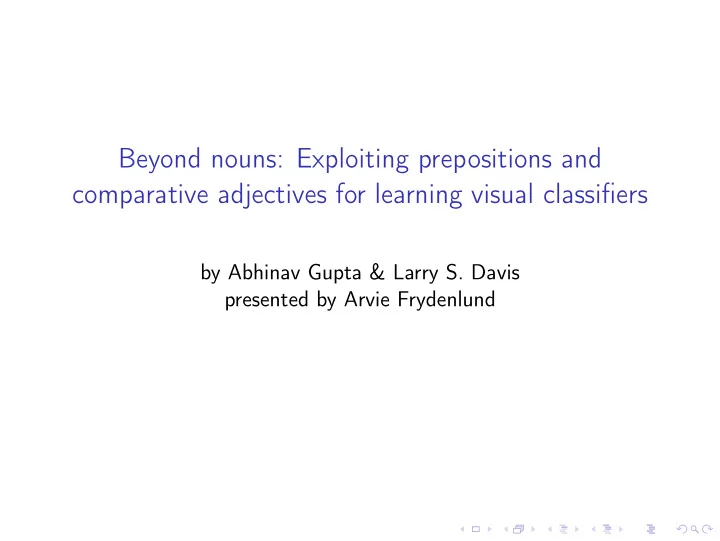

Beyond nouns: Exploiting prepositions and comparative adjectives for learning visual classifiers by Abhinav Gupta & Larry S. Davis presented by Arvie Frydenlund
Paper information ◮ ECCV 2008 ◮ Slides at http://www.cs.cmu.edu/ ∼ abhinavg/ ◮ http://www.cs.cmu.edu/%7Eabhinavg/eccv2008.ppt
Objectives of the paper Task: ◮ Auto-annotation of image regions to labels Methods: ◮ Two models learned ◮ Training model ◮ Learns classifiers for nouns and relationships at the same time ◮ Learns priors on possible relationships for pairs of nouns ◮ Inference model given the above classifiers and priors Issues: ◮ Dataset is weakly labeled ◮ Not all labels are used all the time in the dataset
Weakly labeled data President Obama debates Mitt Romney , while the audience sits in the background. (while the audience sits behind the debaters)
Co-occurrence Ambiguities Only have images of cars that include a street A man beside a car on the street in front of a fence .
Noun relationships Street Car Car Street ◮ On(Car, Street) ◮ P (red labeling) > P (blue labeling)
Prepositions and comparative adjective Most common prepositions: ◮ above, across, after, against, along, at, behind, below, beneath, beside, between, beyond, by, down, during, in, inside, into, near, off, on onto, out, outside, over ◮ since, till, after, before, from, past, to, around, though, thoughout ◮ for, except, about, like, of Comparative adjective: ◮ larger, smaller, taller, heavier, faster http://www.cs.cmu.edu/ ∼ abhinavg/
Relationships Actually Used Used 19 in total ◮ above, behind, beside, more textured, brighter, in, greener, larger, left, near, far, from, ontopof, more blue, right, similar, smaller, taller, shorter
Images and regions ◮ Each image is pre-segmented and (weakly) annotated by a set of nouns and relations between the nouns ◮ Regions are represented by a feature vector based on: ◮ Appearance (RGB, Intensity) ◮ Shape (Convexity, Moments) ◮ Models for nouns are based on features of the regions ◮ Relationships models are based in differential features: ◮ Difference of average intensity ◮ Difference of location http://www.cs.cmu.edu/ ∼ abhinavg/
Egg-Chicken ◮ Learning models for the nouns and relationships requires assigning labels ◮ Assigning labels requires some model for nouns and relationships ◮ Solution is to use EM: ◮ E: compute noun annotation assignments to labels given old parameters ◮ M: compute new parameters given the the E-step assignments ◮ Classifiers are initialized by previous automated-annotation methods i.e. Duygulu et al. , Object recognition as machine translation, EECV (2002)
Generative training model ◮ C A and C R are classifiers (models) for the noun assignments and relationships ◮ I j and I k are region features for regions j and k . I jk are the differential features. ◮ n s and n p are two nouns. ◮ r is a relationship. ◮ L ( θ ) = ( C A , C R ) Fig. 2 from A. Gupta & L.S. Davis
Training ◮ Too expensive to evaluate L ( θ ) directly ◮ Use EM to estimate L ( θ ) , with assignments as hidden values. ◮ Assume predicates are independent given image and assignment ◮ Obviously wrong, since most predicates preclude others ◮ Can’t be ‘on top of’ and ‘beside’
Training relationships modelled ◮ C A , noun model, is implemented as a nearest neighbour based likelihood model ◮ C R , relationship mode, is implemented as a decision stump based likelihood model ◮ Most relationships are modelled correctly ◮ A few were not ◮ In : ‘Not captured by colour, shape, and location’(?) ◮ on-top-of ◮ taller due to poor segmentation algorithm http://www.cs.cmu.edu/ ∼ abhinavg/
Inference model ◮ Given trained C A and C R from the above model ◮ Find P ( n 1 , n 2 , ... | I 1 , I 2 , ..., C A , C R ) ◮ Each region represented by a noun node ◮ Edges between nodes are weighted by the likelihood obtained by differential features Fig. 3 from A. Gupta & L.S. Davis
Experimental setup ◮ Corel5K dataset ◮ 850 training images, tagged with nouns and manually labeled relationships ◮ Vocabulary size 173 nouns, 19 relationships ◮ Same segmentation and feature vectors as Duygulu et al. , Object recognition as machine translation, EECV (2002) ◮ Training model test set 150 images (from training set) ◮ Inference model test set 100 images (given that those images have the same vocabulary) http://www.cs.cmu.edu/ ∼ abhinavg/
Training model evaluation ◮ Use two metrics: ◮ Range semantics: counts number of correctly labeled words, while treating each label with the same weight ◮ Frequency counts: counts number of correctly labeled regions, which weights more frequent words heigher ◮ Compared to simple IBM1 (MT model, 1993) and Duygulu et al. , MT model
Inference model evaluation ◮ Annotating unseen images ◮ Doesn’t use Corel annotations due to missing labels ◮ 24% and 17% reduction in missed labels ◮ 63% and 59% reduction false labels
Inference model examples Duygulu et al. is the top and the paper’s results are the bottom
Inference model Precision-Recall Duygulu et al. is [1]
Novelties and limitations Achievements: ◮ Novel use of prepositions and comparative adjectives for automatic annotation ◮ Use previous annotation models for bootstrapping ◮ Good results Limitations: ◮ Only uses two argument predicates, results in ‘greener’ ◮ Can’t do pink flower example ◮ Assumes one to one relationship between nouns and image segments
Questions? ◮ One of the motivations was the co-occurrence problem. Wouldn’t a simpler model with better training data solve this problem? ◮ Image caption generation to annotation stack? ◮ Model simplification: assuming independence of predicates? ◮ Scale with vocabulary and number of relationships used? ‘Bluer’ and ‘greener’ work for outdoor scenes
Recommend
More recommend